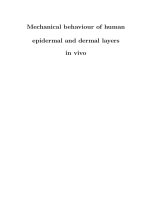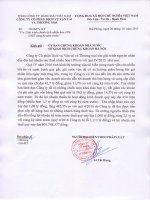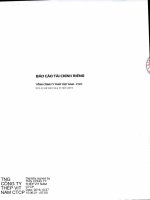Stevens-Johnson and Toxic Epidermal Necrosis, 2016.pdf
Bạn đang xem bản rút gọn của tài liệu. Xem và tải ngay bản đầy đủ của tài liệu tại đây (2.53 MB, 34 trang )
Present : Dr Pham Thi Minh Rang
Internal Department No2-Hospital for children No2
AIMS
To update the use of IVIG and CORTICOIDS IN
management of SJS/ TEN
To remind Doctors being careful when giving
drugs to patients.
BACKGROUND
SJS is an immune-complex-mediated
hypersensitivity complex.
SJS and TEN are the different manifestations of
the same disease.
SJS typically involves the skin and the mucous
membrane: Oral, nasal, eye, vaginal, urethral,
gastrointestinal and lower respiratory tract
mucous membranes.
EPIDEMIOLOGY
From two to seven cases per million people per year.
SJS is more common, outnumbering TEN by as much as 3/1.
The incidence of SJS/TEN is approximately 100-fold higher
among HIV-infected individuals than in the general
population.
SJS/TEN can occur in patients of any age. It is more common
in women than in men, with a male/female ratio of 0.6.
The overall mortality rate among patients with SJS/TEN is
ranging from approximately 10% for SJS to > 30% for TEN.
Mortality continues to increase up to 1 year after disease
onset.
CLASSIFICATION
SJS (A minor form of TEN): <10% BSA detachment.
Mucous membranes are affected in over 90% of
patients, usually at two or more distinct sites
(ocular, oral, and genital).
Overlapping SJS/ TEN: 10-30% BSA detachmnent
TEN: >30% detachment. Mucous membranes are
involved in the majority of cases.
CAUSES
Medications- Most often associated with SJS/TEN are
sulfonamide antimicrobials, phenobarbital,
carbamazepine, and lamotrigine. Others:
acetaminophen, PNC,NAIDS …
Infection -Mycoplasma.pneu, CMV infections are the
next most common trigger of SJS/TEN, Group A beta
Streptococcus, Diptheria , Typhoid, HSV, AIDS, EBV,
hepatitis, influenza, Cocsakie, Mumps, Rickettsia
Coccidioidomycosis, Histoplasmosis, malaria and
Trichomoniasis
SJS is idiopathic in 25-50%
PREDISPOSING FACTORS
Risk factors for SJS/TEN include HIV infection,
genetic factors, underlying immunologic
diseases, and possibly physical factors.
PRODROME
Fever, often exceeding 39°C (102.2°F), influenza-like
symptoms precede by 1 to 3 days the development of
mucocutaneous lesions.
Pain on swallowing may be early symptoms of mucosal
involvement. Malaise, myalgia, and arthralgia…
Eye: Red eye, tearing, dry, itching, pain eye; heavy eyelid
and decrease vision, photophobia and conjunctival itching
or burning…
Skin: Erythroderma, facial edema or central facial
involvement, skin pain, palpable purpura…
Mucous membrane erosion and crusting, swelling of tongue
PHYSICAL
Skin: Rashes-> macules, papules, vesicles,
bullae, urticarial plaques, denuded skin.
Mucosal involvement: edema, sloughing,
blistering , ulceration and necrosis.
Others: tachycardia, hypotension, epitaxis,
conjunctivitis, corneal ulceration, balanitis,
erosive vulvovaginitis, seizure, coma…
LABORATORY ABNORMALITIES
Hematologic abnormalities, particularly anemia and
lymphopenia, are common in SJS/TEN. Eosinophilia
is unusual; neutropenia is present in about onethird of patients, and is correlated with a poor
prognosis. However, the administration of systemic
corticosteroids can cause demarginalization and
mobilization of neutrophils into the circulation, and
this may obscure neutropenia.
LABORATORY ABNORMALITIES
Hypoalbuminemia, electrolyte imbalance, and
increased blood urea nitrogen and glucose may be
noted in severe cases, due to massive transdermal fluid
loss and hypercatabolic state. Serum urea nitrogen >10
mmol/L and glucose >14 mmol/L are considered
markers of disease severity. Mild elevations in serum
aminotransferase levels ( 2 to 3 times the normal value)
are present in about one-half of patients with TEN.
CLINICAL COURSE
The acute phase of SJS/TEN lasts 8 to 12 days and is
characterized by persistent fever, severe mucous
membrane involvement, and epidermal sloughing
that may be generalized and result in large, raw,
painful areas of denuded skin.
Reepithelialization may begin after several days, and
typically requires two to four weeks. Skin that
remained attached during the acute process may
peel gradually and nails may be shed.
Diagnosis and Differential Diagnosis
Skin biopsy is the definitive diagnosis.
Skin biopsy specimens demonstrate that the
bullae are subepidermal. Epidermal cell may
be noted. Perivascular areas are infiltrated
with Lymphocytes.
Differential Diagnosis: Burn, conjunctivitis,
dermatitis, scleritis, sarcoidosis, Sjogren, 4S,
irradiation, trauma, scleroderma…
COMPLICATIONS
Acute phase - In severe cases with extensive skin
detachment, acute complications may include
massive loss of fluids through the denuded skin,
electrolyte imbalance, hypovolemic shock with renal
failure, bacteremia, sepsis and septic shock, insulin
resistance, hypercatabolic state, and multiple organ
dysfunction syndrome. Abdominal compartment
syndrome secondary to excessive replacement fluid
therapy has been reported in a few patients.
COMPLICATIONS
Pulmonary complications( eg, pneumonia,
interstitial pneumonitis), the risk of progression to
acute respiratory distress syndrome.
Gastrointestinal complications may result from
epithelial necrosis of the esophagus, small bowel, or
colon. (Diarrhea, melena, small bowel ulcerations,
colonic perforation, and small bowel
intussusception…)
Long-term sequelae
Ophthalmologic sequelae develop in approximately 50 to 90% of
patients include dry eye, photophobia, ingrown eyelashes,
neovascularization of the cornea, keratitis, and corneal scarring
leading to visual impairment and rarely blindness.
Oral and dental sequelae are not rare and include mouth
discomfort, xerostomia, gingival inflammation and synechiae,
caries, and periodontal disease. Severe dental growth
abnormalities, such as dental agenesia, root dysmorphia…
Dermatologic sequelae are common and include irregular
pigmentation, eruptive nevi, abnormal regrowth of nails,
alopecia, scarring.
Criteria for admission
Minor may be treated as outpatient with topical
steroid->daily follow-up
Major : must be hospitalized.
Transfer criteria would be the same as for the
patients with thermal burns (grade 2C)
a SCORTEN score of 0 or 1, and disease that is not
rapidly progressing may be treated in nonspecialized
wards. Patients with more severe disease and a
SCORTEN score ≥2 should be transferred to intensive
care units or burn units if available.
Prognosis-Scorten score(Grade 2C)
Age>=40
Malignancy : yes
BSA detached>= 10%
Tarchycardia>= 120/min
Serum urea>=10mmol/l
Serum glucose>=14mmol/l
Serum bicarbonate<20mmol/l
Mortality rates are as follows:(0-1;3,2%) (2;>=12,1%)
(3;>=35,3%) (4;>=58,3%) (>=5;>=90%)
Use on days one and three of hospitalization for SJS/TEN
Treatment
No specific drug treatment has been consistently shown
to be beneficial in the treatment of SJS. The best
management is supportive care.
Supportive care: wound care, fluid and electrolyte
managemnet, nutrition support, ocular care,
temperature and pain control, monitoring
for/treatment of superinfection.
Corticoid, IVIG, plasmapheresis, TNF inhibitors
Evaluate the extent of epidermal detachment daily by
percentage of BSA.
ANTIBIOTICS
Antimicrobials are indicated in cases of urinary
tract or cutaneous infections, either of which
may lead to bacteremia
Prophylactic systemic antibiotics are not useful
esp. in the current of multiple-drug resistance
CORTICOID.1
A large multicenter European study, suggested that
a short course of moderate to high dose of systemic
corticosteroids( eg, prednisone 1 to 2 mg/kg/ day
for 3 to 5 days) may not be harmful and may have a
beneficial effect if given early in the course of the
disease( ie, within 24 to 48 hours of symptom
onset).
CORTICOID.2
In a systematic review of treatment of SJS/TEN in
children, including 31 case series with 128 patients,
20 patients received either prednisolone or
prednisone (1 mg/kg/d) or methylprednisolone (4
mg/kg/d) for 5 to 7 days. No deaths were reported;
complications occurred in five patients (mild skin
infections in three children and bronchiolitis in two).
CORTICOID.3
In a retrospective analysis of 281 patients with SJS/TEN
from France and Germany enrolled in the EuroSCAR study,
159 patients received variable doses of corticosteroids
(ranging from 60 mg to 250 mg per day of prednisone
equivalents), 75 IVIG (40 in association with
corticosteroids), and 87 supportive care alone. The
mortality rate was 18 percent in the corticosteroid group,
25 percent in the IVIG group, and 25 percent in the
supportive care group. The odds ratio of death for patients
treated with corticosteroids compared with patients treated
with supportive care alone was 0.6 (95% CI 0.3-1.0),
suggesting a potential benefit.
CORTICOID.4
subsequent analysis of 442 patients from the RegiSCAR
cohort did not find a survival advantage for patients treated
with systemic corticosteroids, compared with patients
treated with supportive therapy only (hazard ratio 1.3, 95%
CI 0.8-1.9).
In a systematic review of 439 patients with SJS/TEN, the
mortality rate was 22 percent among patients treated with
systemic corticosteroids and 27 percent among those
treated with supportive measures only. In both groups,
mortality rates were similar to those predicted by the
SCORTEN score, without any significant difference related to
the type of treatment.
CORTICOID.5
Case-control study examined the effect of previous
corticosteroid therapy on the course and outcome of
SJS/TEN. The study included 92 SJS/TEN patients who
were on corticosteroid therapy before the onset of
disease and 321 randomly selected SJS/TEN patients
not previously exposed to corticosteroids. The exposure
to corticosteroids before the onset of SJS/TEN did not
affect the disease severity and mortality; however,
corticosteroids prolonged the latency (time from drug
initiation to onset of disease) and progression of
disease









